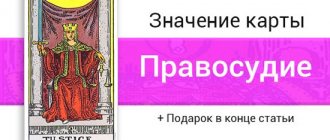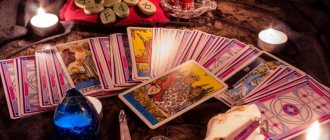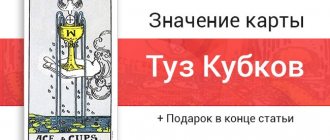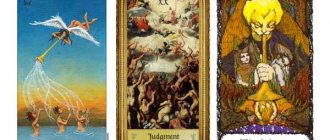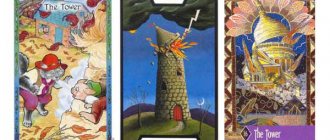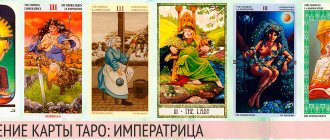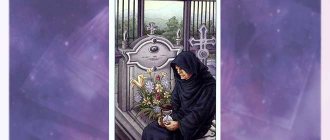» Tarot » Aleister Crowley's Tarot of Thoth
0
680
Article rating
Aleister Crowley's Mystical Tarot of Thoth is the second most popular deck for fortune telling. The Rider Waite deck takes precedence, but is inferior, however, to Crowley's system in the abundance of symbolism. The meaning of the Thoth Tarot cards has a unique philosophical meaning.
Aleister Crowley's Tarot of Thoth
The meaning of the Knight of Cups Tarot card for fortune telling
The meaning of the Knight of Cups of the Tarot in fortune telling represents the ability to instill in other people everything that is needed to complete the task of the fortuneteller.
He has a hidden intention, and in order to bring it to life, he is forced to use those around him. If you get this card, it foretells receiving an offer or working towards a new goal. There is a possibility that new people will appear in your life, but it’s hard to say whether they are friends or enemies. The event most likely to relate to emotions or relationships - holidays, parties, weddings and other positive events. But business contacts are also possible. In general, the Knight of Cups foretells friendly relations and a good atmosphere. The conflicting aspects of life will finally cease to be so. This is the right time to enjoy harmony, meditate and start a new romantic relationship. It's worth spending time on art, especially music. Listening to pleasant musical compositions, concerts of your favorite performers will have a positive effect on your mood, and maybe you should even try yourself as a musician and sign up for appropriate lessons.
Inverted, the Tarot card Prince of Cups speaks of easy suggestibility and even possible dependence on the opinions and actions of others. Probably, the fortuneteller becomes a victim of cunning manipulations or lies. Having received a proposal, you should check all aspects of the current situation. The offer may turn out to be insincere, however, it is quite tempting and even captures your imagination. Beware of understatements and half-truths, otherwise you may regret your decision more than once. A consultation with an uninterested person will help you recognize truth and lies.
Major Arcana
In his book, Crowley calls the major arcana "atu" and correlates them with the paths connecting the numbers on the Sephiroth tree. 2 senior atu help to understand the situation and consider the great archetypes and sacred laws of the Universe in it.
Fool (0)
The Fool (or Fool) is a Kabbalistic zero, a vacuum, the source of everything. The Fool in the Thoth Tarot is a “green man” in whom spring, freedom, romance awakens and at the same time madness and recklessness.
Magician (1)
Magician (or Magician) – Principles, will, energy directed to the outside world. This is a symbol of the creative Word and a creator who can be both honest and cunning. A magician creates an illusion.
High Priestess (2)
The lasso symbolizes spirituality and initiation into secrets, strength emanating from a divine source. The Priestess is a pure feminine archetype and intuitive knowledge. In a narrow sense, the 2nd lasso symbolizes the unconscious and secrets.
Empress (3)
A symbol of feminine energy – spiritual and material. The Empress signifies vitality, fertility, abundance. The 3rd lasso speaks of creativity and creation. Its meaning in a narrow sense is earthly love, sensual pleasures, pregnancy.
Emperor (4)
The 4th lasso symbolizes masculine and paternal energy, dominion. The Emperor establishes order through courage, wisdom and willpower. In a narrow sense, this is responsibility.
Hierophant (5)
The power of faith. The Hierophant symbolizes the spiritual search and finding one's own Self. The 5th atu warns against excessive dogmatism and intellectual complacency.
Lovers (6)
A combination of feminine and masculine principles. Lovers symbolize sincerity and courage in decisions coming from the heart. Also, the 6th atu signifies reconciliation, the unification of contradictions.
Chariot (7)
The center of spiritual forces that set everything in motion. The Chariot is a firm intention, confidence, wisdom in overcoming internal contradictions. The 7th atu directs spiritual forces to achieve integrity and movement towards a higher goal.
Regulation (8)
The card is also called Justice, but Crowley believed that the code to understanding the archetype was Regulation. The 8th atu symbolizes balance and the forces of nature. This is karma, in which every action has consequences.
Hermit (9)
A symbol of reflection on true values and adaptation of your ego to them. A hermit involves withdrawing into oneself from external vanity. The 9th atu teaches humility, contemplation, wisdom and seriousness.
Fortune (10)
The Arcanum is also called the Wheel of Fortune and describes the cycles of fate - ups and downs. The 10th atu speaks of the naturalness of change - both happy and fatal. In many cases, Fortune is karmic luck (but it can also be the other way around).
Lust (11)
The Arcana of Strength in Crowley's book is called Lust or Lust, symbolizing the strength of the animal passions hidden in man. The 10th atu suggests recognizing them and not suppressing them, but using love for your own purposes, directing the energy of lust in the right direction.
Lust in the Thoth Tarot symbolizes the power of animal passions hidden in man
Hanged Man (12)
The 12th atu symbolizes an unusual point of view. It helps resolve impasses and overcome crises. In addition, the Hanged Man signifies sacrifice - the abandonment of forgotten values that no longer work.
Death (13)
The 13th atu reflects the process of dying and rebirth in a new life. These are necessary transformations that cannot be avoided. Atu Death speaks of the end of problems and the beginning of a new path.
Art (14)
Arcana Art is also called Moderation. The 14th atu symbolizes ideal balance, the ability to overcome contradictions with the precision of combined proportions. Advice from the card Art consists of activating the weakly expressed sides of the personality.
Devil (15)
The lasso reflects the energy of material creativity and its shadow side: greed, passions, dependence, corruption. In essence, the Devil is the shadow side of all the arcana. This is a map of chaos and the lower worlds, in which it is easy to get confused.
Tower (16)
The 16th atu symbolizes the power of destruction. The card denotes a catastrophe or a blow of fate, which, nevertheless, frees one from the past. The tower is the collapse of outdated values that hinder development.
Star (17)
The power of inspiration and encouragement, hope, love of life. Understanding the higher laws of existence frees you from fears and worries. The star gives lightness and carefreeness, symbolizes success and prospects.
Moon (18)
The 18th atu leads to the depths of the unconscious, inhabited by fears and secret desires. The moon is an illusion and impermanence, as well as a difficult path to travel. For anyone who is not afraid to look into the mirror of the unconscious, the card gives a chance to learn something important.
Sun (19)
A bright period filled with happiness and vitality. The sun is victory, liberation of the soul, achievement of higher values. The 19th atu promises good health, joy and pleasure, spiritual insight.
Eon (20)
In classic decks of the 20th atu, the Aeon is called Judgment and symbolizes the results of the past period. Crowley focuses on the beginning of a new stage, reaching another level of development. Aeon signifies spiritual transformation - another step towards realizing the Higher Self.
Universe (21)
The last card of the major arcana speaks of achieving a goal, receiving satisfaction from integrity. The Universe is the completion of a certain stage in development, awareness of one’s place in life. The card brings joy, fulfillment, love and unity.
Knight of Cups Tarot - meaning in readings for work and business
Mainly, the Knight of the Suit of Cups demonstrates the fortuneteller’s attitude towards his activities and the atmosphere that reigns in his team. However, this map does not currently reveal anything about the content of the workflow. If this question interests you, you should pay attention to the remaining cards of the layout.
The Knight of the Suit of Cups speaks of a calm and friendly atmosphere at work. The work process proceeds routinely, there are no urgent matters or worries. Everything is going according to the originally planned plan. Work does not spoil the life of the questioner and brings him pleasure, at least at this stage.
If the question was asked regarding a change of workplace, this card answers it by indicating the creative direction of activity. You've been interested in trying a new industry for a long time, and one that taps into your inner artist is the right one for you. However, it is unknown whether you will decide to make such changes or whether your dreams of a creative career will remain just dreams.
If a reversed Knight of Cups appears in a fortune-telling for a business or job, there is a high probability of deception. You should carefully read all the papers you sign for the fine print. If you are in doubt, do not rush to make a decision. Advice from an uninterested person or a professional you hire will help you avoid becoming a victim of fraud.
Wands
This suit is associated with the fire element. She is characterized by speed and sharpness, struggle, strength and valor. The minor arcana of Wands are geared toward victory and dominance.
- Ace of Wands - awakening of spiritual fire, a new opportunity, the need to take risks.
- Two of Wands – aggressive energy, speed, desire to conquer.
- Three of Wands – creative energy, a sense of confidence, interaction.
- Four of Wands – order, balance.
- Five of Wands – struggle, resistance and competition for development.
- Six of Wands – overcoming conflict, victory, harmony and optimism.
- The Seven of Wands is an energy decline that requires courage and courageous actions.
- Eight of Wands – the emergence of new ideas, learning, intellectual work.
- Nine of Wands – creative resources, concentration, self-expression.
- Ten of Wands - restrictions, the desire for success under the weight of a burden.
- Princess of Wands - impulse to action, thirst for life and adventure, enthusiasm.
- Prince of Wands – fresh energy, passion, impatience and impulsiveness.
- Queen of Wands – maturity, depth, inner strength and independence.
- Knight of Wands – intelligence, determination, self-confidence, humanism.
Knight of Cups Tarot - meaning at the level of consciousness
The Tarot Horseman of Cups warns you against over-concentrating on the external aspects of the offer you receive. So you may not notice its true content. Think carefully about the consequences before you take a step. Beware of deceiving appearances.
The Knight of Cups also warns about possible self-deception. There is a possibility that a fortuneteller, guided by emotions, creates a picture of worldview full of illusions. You are filled with delight, perhaps you recently received good news, and now you look at the world exclusively through rose-colored glasses.
This card can also indicate the fortuneteller’s interest in mysticism and dreams. However, the Knight of Cups says that the view of myths, legends and other sources will remain superficial. An in-depth study of this knowledge is not expected at this stage.
Knight of Cups Tarot - meaning in relationships
The meaning of the Knight of Cups Tarot, when it falls to a lonely person, speaks of the emergence of a new feeling. You will probably fall in love. Emotionally, you are ready for a new relationship and feel confident. But before you start a new relationship, you should make sure that your partner’s feelings are sincere. There is a high probability that your new friend is involved in the world of art. He is distinguished by strong imaginative thinking and developed imagination.
The period foreshadowed by the Knight of Cups is ideal for new romantic meetings, falling in love and romance. However, do not forget that the intentions of an unfamiliar new partner may not be very honest. Sometimes this card foreshadows the receipt of a marriage proposal.
The main significance in the relationship of the Knight of Cups Tarot lies precisely in the period of the beginning of the relationship. However, when it comes to an established partnership, this card foreshadows the approach of reconciliation and mutual understanding. For married couples, the card promises an extremely pleasant period in the relationship.
The reversed Knight of Cups promises disagreements and other problems in relationships. There is a high probability of a painful breakup, as well as betrayal and lies on the part of a loved one. You may be very disappointed with your partner.
Swords
The suit of Swords corresponds to the air element. Key concepts: intelligence, analysis, confrontation. Swords often warn of dangers, conflicts, failures, and health problems.
- Ace of Swords - the power of knowledge, activity, clarification of the problem.
- Two of Swords – structuring, combining contradictions, reasonable solutions.
- Three of Swords – loss of illusions, resentment, breakup, sadness.
- Four of Swords – truce and respite.
- Five of Swords - collapse and betrayal, defeat leading to new development.
- Six of Swords – expanded perception, knowledge, new vision.
- Seven of Swords – deception or self-deception, self-pity, futility, limitations.
- Eight of Swords – slowdown in development, interference from outside forces, anxiety, absent-mindedness.
- Nine of Swords – aggression, cruelty and suppression, fears, weakness, guilt.
- Ten of Swords – violent end of the cycle, bitter experience, disintegration.
- Princess of Swords – excess energy, impulsiveness, nervousness, conflict.
- Prince of Swords – aggressive thinking, breakthrough, movement, excessive enthusiasm.
- Queen of Swords – independent mind, logic, resourcefulness.
- Knight of Swords – power of intellect, insight, eloquence.
What personalities does the Knight of Cups Tarot represent?
The Knight of Cups of the Tarot, when in an upright position, is a faithful friend or spouse. He is distinguished by his ability to diplomacy. It is extremely likely that this person is religious. The opinions of others do not bother him; he is busy fulfilling a mission that is of great importance to this person. The knight does not know whether his cup is full or empty, but is ready to share its contents and accept the gift with gratitude.
The Knight of Cups typically represents people between the ages of 18 and 25, sometimes precocious teenagers who are sedate and mature. They are hungry for knowledge and eager to learn. Such people are characterized by dreaminess, idealism, artistry and sophistication. Often these are creative individuals who choose appropriate professions. However, they often love to work with people and become good psychologists, doctors, consultants, and achieve success in sales.
Sometimes this card represents a person who is in love with you, as well as his lover or a person who is trying to seduce you. It is likely that this is the man of your dreams when a girl tells fortunes.
The reversed Knight of Cups indicates a weak-willed person who often uses flattery and sycophancy. This is a scammer or a person who misleads you by telling only part of the truth. He is lazy and childish. When such a person faces problems, he prefers to escape from reality. Such people do not tolerate responsibility, especially when it comes to problems of an emotional nature.
Sometimes an inverted card speaks of a loved one who is deceiving the fortuneteller. He is a hopeless romantic, but his ideas about love and loyalty do not always correspond to conventional wisdom.
Knight of Cups in Tarot combinations
Knowing the combinations of Tarot cards will help you make a more accurate forecast using cards, and the Knight of Cups in this case is no exception. Almost every card can have a refined meaning or change interpretation as a result of combination with other cards from the deck.
The combination of the Knight of Cups Tarot with the Hierophant lasso speaks of fusion. This is a proposal that concerns marriage, joining forces with someone, other options are possible. But the combination with the Lovers lasso always concerns only marriage proposals. If the Knight of Cups appears together with the Tower card, this, on the contrary, foreshadows a divorce, dismissal or refusal of business partners.
If the Knight of Cups lies next to the Sun card, this indicates the need to agree to the proposal or confirms that someone will like your proposal. The combination with the Court recommends asking for help from higher powers - besides them, in this situation there is simply nowhere to expect help.
Deck Features
Aleister Crowley's Tarot cards are sometimes called "satanic" due to the author's notorious fame. In themselves they do not bring evil, but they appeal to the human unconscious.
Thoth Tarot cards differ from the universal Waite deck in greater complexity. Their drawings are full of symbolic elements that greatly expand the usual interpretations.
Deck Guide
Aleister Crowley shared the opinion about the magical origin of the Tarot - according to legend, they were created by ancient magicians led by Thoth (or Hermes Trismegistus). Crowley presented his interpretation of the deck to the world in the mid-twentieth century, developing drawings together with artist Frieda Harris. The author has written an extensive guide to his deck called The Book of Thoth. This work contains not only a description of the cards, but also traces the connection of the Tarot with ancient traditions, Kabbalah, magic, and animism.
Modern authors are improving fortune telling by offering their own interpretations of Thoth cards and astrological additions to them. Today you can guess using the Crowley system online by choosing cards for the layout from the gallery. But interpretation of cards is only a base that needs to be supplemented with your own intuition.
Knight of Cups from the Thoth Tarot - card features
In the Thoth Tarot deck, the Prince of Cups has large wings that give him the ability to soar on a white horse. The prince is dressed in green armor. Its bowl contains a crab or other crustacean. In addition, on the map you can see an image of a peacock.
The Knight of Cups card from the Thoth Tarot has a meaning similar to the traditional interpretation of this card, but much attention is paid to the symbolism of the image on it. Thus, the crab, which is considered a sign of the element of Water, is considered a symbolic image of marital relations. The light wings of the Knight of Cups speak of the sublimity of feelings. The peacock, which is usually considered a symbol of vanity and narcissism, offers its beauty to decorate this world. The Knight's green armor symbolizes his creative nature.
According to the interpretations for the Thoth Tarot, the Prince of Cups indicates the search for a true family or a partner who is suitable for marriage. This card suggests that the questioner needs a society where he will feel at ease. You crave communication with like-minded people, and this is exactly what you need to strive for now.
In general, the Knight of Cups speaks of the ability to suggest, which often helps in life. Also, this card can foreshadow new romantic feelings, but sometimes it also speaks of hidden intentions and half-truths - it all depends on many factors, which are both the type of layout itself and various combinations with other cards.
Princes
To contents
Princes
The Four Princes are united by the idea of air, that is, intellect. Each of the Princes is a kind of logos of his element. Air is between heaven and earth, he is Shu or Atlas, who supports the sky. Air as an element is the essence of the thinking process. The chariot itself, driven by any of the Princes, seems to hint to us at the first miracle of engineering genius in the history of mankind - a chariot invented by the very first great inventor.
Therefore, Princes are always those who change the established status quo. Their task is to be both creators and destroyers. Princes are freer than Kings, because nothing belongs to them. All that will belong to them is what they themselves can conquer with their mind and will. Therefore, unlike Kings, who, as a rule, are conservative (perhaps with the exception of the King of Wands - a reformer on the throne), Princes always strive to subject reality to some kind of radical transformation.
The most striking bearer of this strategy is the Prince of Wands - the air of fire. The essence of the Prince of Wands is transgression, disruption, rebellion. As a person, the Prince of Wands always attacks the generally accepted boundaries of decency and morality. He is an eternal subverter of prejudices, a rebel and a brawler. Confronting current culture, the Prince of Wands always strives for the culture of the future.
Prince of Wands
Typical representatives of this card were people such as Giordano Bruno, Faust, Aleister Crowley, Timothy Leary. Prince Zhezlov is a hero of the counterculture; the most important thing for him is the implementation of his ideas in the future. The Prince of Wands helps to understand why Carl Jung associated the function of intuition with fire. Prince Zhezlov simply sees the future, and if the future does not want to be as he sees, it’s worse for him - it’s not for nothing that this Prince’s cart is harnessed not by horses, but by ferocious lions.
For him, revolution is a desirable element, be it a political or sexual revolution. He is an absolute neophile, “new” for him is synonymous with “good”, and “conservative” is the worst curse word. In some cases, the Prince of Wands may appeal to “ancient wisdom”, but in the end this is nothing more than a rhetorical device for him - he will easily pass off the latest discoveries of quantum physics as ancient wisdom if necessary.
In the layouts, the Prince of Wands indicates creative mobilization, the struggle for independence, self-affirmation, and choosing one’s own path. For him, his intellect, will, and discipline are very important, but all this is aimed not at serving the existing order of things, but at changing and destroying the old or building something fundamentally new. The Prince of Wands is the logos of fire - in other words, the power that gives the destructive elements names and meanings, transforming pure destruction into the birth of a new world.
The Prince of Cups is the exact opposite of the Prince of Wands. For him, all social and ideological wars are nothing more than strange quirks. His goal is eroticism in all its possible forms and manifestations. The Prince of Cups can act as a romantic poet, a “pale youth with a burning gaze,” a rock musician, a lover, a seducer, a rake. Typical representatives of the Prince of Cups in history are Giacomo Casanova, Jim Morrison, John Lennon, Charles Baudelaire.
Prince of Cups
Not every poet is the Prince of Cups. The same Bryusov, whose line about the “pale youth” we quote, would have been much more suitable as a significator for the King of Wands. But, without a doubt, every Prince of Cups is a little poet, even if he has not written a single quatrain. His poetry lies in the romantic halo that surrounds him, making him irresistible to women. The Prince of Cups can take on a variety of images - from a romantic and dreamy wanderer-minstrel to a sophisticated socialite who knows a lot about the game of love. What they have in common is that their natural forte is the element of pure feeling. Water is a very dangerous element, but the Prince of Cups manages to interact with it almost without loss, because he himself is water.
But the Prince of Cups is not just water, it is the very logos of water, the word of the depths, the expression of the water element. The Logos of the waters always argued with the Logos of the heavens, just as the first Minnesingers and Trouvères opposed dogmatic Christianity, even if they formally agreed with it and used Christian images. Here, in the universe of water, where everything is foggy, everything is vague, everything is meaningful, the Prince of Cups easily plays with meanings, and meanings easily turn into their opposites, enchanting with their play.
Prince of Swords
The Prince of Swords is a card of absolute air, that is, rationalism taken to the limit. The property of the Prince of Swords is a complete withdrawal into the world of pure abstractions. As soon as we look at the map, we understand that everything that is happening is a clear illustration of the expression “having our head in the clouds.”
The trouble with the Prince of Swords is that his mind is not looking for anything else. We have already said that logos, thought, is the basic category of all four Princes. But the thought of the Prince of Wands is directed to culture, the Prince of Cups to the erotically attractive other, and the Prince of Disks to matter. The Prince of Swords cannot direct his thought to anything other than himself. This is a thought, a thinking thought. Thought directed at thought. As a result of this design, something like the same mirror corridor of illusions is obtained, but this time the illusions are not of an erotic nature, like the Queen of Cups, but of an intellectual nature.
A clear illustration of the absurdity of the despotism of the intellect are sophisms in the spirit of Achilles, who can never catch up with the tortoise, or the Cretan, who says that all Cretans are liars. Rational and linear thinking too easily falls into the double-loop trap and is unable to comprehend why a particular law does not work if, as a logical structure, it seemed flawless. So, we have all met people who absolutely know how to live correctly, and can convincingly justify why their theory is the best and why they themselves could not achieve anything with the help of this theory. The Prince of Swords is a virgin who writes a book about seduction, or a city dweller who talks about the superiority of the countryside over the city. His logic led him to ideas that had nothing to do with his actual status or his future. Unlike the King of Swords, who is determined to implement his ideas, the Prince of Swords will suffer a real disaster. if he tries to test his ideas in practice.
Prince of Disks
The exact opposite of the Prince of Swords is the Prince of Disks. His strong intellect is turned to matter, and only to matter. The archetypal prototype of the Prince of Disks is Hephaestus - this heavenly blacksmith, who always pleases Olympus with the inventions of his forge. It is important to understand that the Prince of Disks is not just a hard worker who finds himself in the thrall of matter, but a creative inventor for whom the material world is the only thing worthy of attention. In the history of science, the most prominent representative of this type is Edison, whose motto was “not a single useless invention.” Abstract science and new theoretical models were of no interest to Edison if they could not be immediately converted into concrete inventions.
The Prince of Disks is a “master of golden hands.” Gold is the metal of the Sun and consciousness, and the expression “golden hands” is not accidental: it indicates that it is the hands, as a space of operational action, that have the qualities of consciousness, the qualities of the spirit.
The strengths of the Prince of Disks are his practicality, intelligence, independence and colossal self-discipline (something that the Princes of Cups and Swords lack so much). However, sometimes he lacks imagination. Absorbed by attention to matter, the Prince of Disks is blind and deaf to cultural and interpersonal values, in the space of which his competitors feel like fish in water.
Princes in the Tarot Visonti – Sforza
Marseille Tarot
To contents
